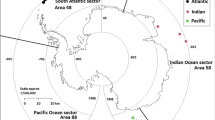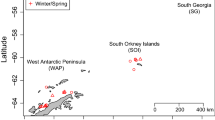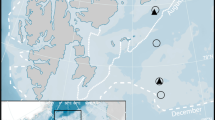Abstract
Our study deals with the lipid biochemistry of the krill community in the ecosystem of the high Arctic Kongsfjord (Svalbard). During the last decades, Kongsfjord experienced a change in krill species composition due to recent increased advection of Atlantic water masses carrying characteristic boreal as well as subtropical-boreal euphausiids into the ecosystem. The lipid biochemistry and trophic relationships of the species recently inhabiting the Arctic water masses are scarcely known, although a change in a krill population may have a significant impact on the ecosystem. A comparison of nutrition and energy storage strategies, stable isotopes, lipid profiles and fatty acid compositions showed remarkable differences between the krill species. These reflected the diverse feeding behaviours and specific adaptations to the environments of their origin: the boreal Meganyctiphanes norvegica and subtropical Nematoscelis megalops appear more carnivorous and have significantly lower mean lipid contents (29 and 10 %, respectively) and a different energy storage pattern (triacylglycerols and polar lipids, respectively) than the arcto-boreal Thysanoessa inermis, which consists of up to 54 % of lipids mainly stored as wax esters (>40 %). These differences may have significant implications for the rapidly changing marine food web of Kongsfjord—especially for higher trophic levels relying on the nutritional input of animal lipids.




Similar content being viewed by others
References
Auel H, Harjes M, da Rocha R, Stübing D, Hagen W (2002) Lipid biomarkers indicate different ecological niches and trophic relationships of the Arctic hyperiid amphipods Themisto abyssorum and T. libellula. Polar Biol 25:374–383
Barange M, Gibbons MJ, Carola M (1991) Diet and feeding of Euphausia hanseni and Nematoscelis megalops (Euphausiacea) in the northern Benguela Current: ecological significance of vertical space. Mar Ecol Prog Ser 73:173–181
Basedow SL, Eiane K, Tverberg V, Spindler M (2004) Advection of zooplankton in an Arctic fjord (Kongsfjorden, Svalbard). Estuar Coast Shelf Sci 60:113–124
Berkes F (1976) Ecology of euphausiids in the Gulf of St. Lawrence. J Fish Res Board Can 33:1894–1905
Beyer F (1992) Meganyctiphanes norvegica (M. sars) (Euphausiacea) a voracious predator on Calanus, other copepods, and ctenophores, in oslofjorden, southern Norway. Sarsia 77:189–206
Boyd SH, Wiebe PH, Cox JL (1978) Limits of Nematoscelis megalops in the northwestern Atlantic in relation to Gulf stream cold core rings. II. Physiological and biochemical effects of expatriation. J Mar Res 36:143–159
Buchholz F, Buchholz C, Weslawski JM (2010) Ten years after: krill as indicator of changes in the macro-zooplankton communities of two Arctic fjords. Polar Biol 33:101–113
Cartes JE (2011) Temporal changes in lipid biomarkers, especially fatty acids, of the deep-sea crustaceans Boreomysis arctica and Nematoscelis megalops: implications of their biological cycle and habitat near the seabed. J Mar Biol Assoc UK 91:783–792
Clarke A (1980) The biochemical composition of krill, Euphausia superba dana, from South Georgia. J Exp Mar Biol Ecol 43:221–236
Cripps GC, Atkinson A (2000) Fatty acid composition as an indicator of carnivory in Antarctic krill, Euphausia superba. Can J Fish Aquat Sci 57:31–37
Cuzin-Roudy J, Buchholz F (1999) Ovarian development and spawning in relation to the moult cycle in Northern krill, Meganyctiphanes norvegica (Crustacea: Euphausiacea), along a climatic gradient. Mar Biol 133:267–281
Dalpadado P, Bogstad B (2004) Diet of juvenile cod (age 0–2) in the Barents Sea in relation to food availability and cod growth. Polar Biol 27:140–154
Dalpadado P, Ikeda T (1989) Some observations on moulting, growth and maturation of krill (Thysanoessa inermis) from the Barents Sea. J Plankton Res 11:133–139
Dalpadado P, Mowbray F (2013) Comparative analysis of feeding ecology of capelin from two shelf ecosystems, off Newfoundland and in the Barents Sea. Prog Oceanogr 114:97–105
Dalpadado P, Yamaguchi A, Ellertsen B, Johannessen S (2008) Trophic interactions of macro-zooplankton (krill and amphipods) in the Marginal Ice Zone of the Barents Sea. Deep Sea Res Part II 55:2266–2274
Dalpadado P, Ingvaldsen RB, Stige LC, Bogstad B, Knutsen T, Ottersen G et al (2012) Climate effects on Barents Sea ecosystem dynamics. ICES J Mar Sci 69:1303–1316
Dalsgaard J, St John M, Kattner G, Müller-Navarra DC, Hagen W (2003) Fatty acid trophic markers in the pelagic marine environment. Adv Mar Biol 46:225–340
Dolgov AV, Johannesen E, Heino M, Olsen E (2010) Trophic ecology of blue whiting in the Barents Sea. ICES J Mar Sci 67:483–493
Einarsson H (1945) Euphausiacea. I. Northern Atlantic species. Bianco Luno, Copenhagen
Ellingsen IH, Dalpadado P, Slagstad D, Loeng H (2008) Impact of climatic change on the biological production in the Barents Sea. Clim Change 87:155–175
Falk-Petersen S, Gatten RR, Sargent JR, Hopkins CC (1981) Ecological investigations on the zooplankton community in Balsfjorden, Northern Norway: seasonal changes in the lipid class composition of Meganyctiphanes norvegica (M. Sars), Thysanoessa raschii (M. Sars), and T. inermis (Krøyer). J Exp Mar Biol Ecol 54:209–224
Falk-Petersen S, Hopkins C, Sargent J (1990) Trophic relationships in the pelagic, Arctic food web. In: Barnes M, Gibson RN (eds) Trophic relationships in the marine environment: proceedings of the 24th European marine biology symposium. University Press, Aberdeen, pp 315–333
Falk-Petersen S, Hagen W, Kattner G, Clarke A, Sargent J (2000) Lipids, trophic relationships, and biodiversity in Arctic and Antarctic krill. Can J Fish Aquat Sci 57:178–191
Falk-Petersen S, Pavlov V, Timofeev S, Sargent JR (2007) Climate variability and possible effects on arctic food chains: the role of Calanus. In: Ørbæk JB, Kallenborn R, Tombre I, Hegseth EN, Falk-Petersen S, Hoel A (eds) Arctic alpine ecosystems and people in a changing environment. Springer, Berlin, pp 147–166
Fisk AT, Hobson KA, Norstrom RJ (2001) Influence of chemical and biological factors on trophic transfer of persistent organic pollutants in the Northwater Polynya marine food web. Environ Sci Technol 35:732–738
Folch J, Lees M, Sloane-Stanley GH (1957) A simple method for the isolation and purification of total lipids from animal tissues. J Biol Chem 226:497–509
Gjøsæter H, Dalpadado P, Hassel A (2002) Growth of Barents Sea capelin (Mallotus villosus) in relation to zooplankton abundance. ICES J Mar Sci 59:959–967
Gradinger R (1995) Climate change and biological oceanography of the Arctic Ocean. Philos Trans R Soc A 352:277–286
Graeve M, Janssen D (2009) Improved separation and quantification of neutral and polar lipid classes by HPLC–ELSD using a monolithic silica phase: application to exceptional marine lipids. J Chromatogr B 877:1815–1819
Graeve M, Kattner G, Hagen W (1994) Diet-induced changes in the fatty acid composition of Arctic herbivorous copepods: experimental evidence of trophic markers. J Exp Biol 182:97–110
Graeve M, Kattner G, Piepenburg D (1997) Lipids in Arctic benthos: does the fatty acid and alcohol composition reflect feeding and trophic interactions? Polar Biol 18:53–61
Greenacre M (2006) Tying up the loose ends in simple, multiple, joint correspondence analysis. In: Rizzi A, Vichi M (eds) Compstat 2006—Proceedings in computational statistics. Physica-Verlag, Heidelberg, pp 163–185
Greenacre M (2011) Measuring subcompositional incoherence. Math Geosci 43:681–693
Greenacre M, Primicerio R (2013) Multivariate analysis of ecological data. Fundación BBVA, Bilbao
Greene CH, Wiebe PH, Burczynski J, Youngbluth MJ (1988) Acoustical detection of high-density krill demersal layers in the submarine canyons off Georges Bank. Science 241:359–361
Gurney LJ, Froneman PW, Pakhomov EA, McQuaid CD (2001) Trophic positions of three euphausiid species from the Prince Edward Islands (Southern Ocean): implications for the pelagic food web structure. Mar Ecol Prog Ser 217:167–174
Hagen W (2000) Lipids. In: Harris RP, Wiebe PH, Lenz J, Skjodal HR, Huntley M (eds) ICES zooplankton methodology manual. Academic Press, London, pp 113–119
Hagen W, Kattner G, Terbrüggen A, van Vleet ES (2001) Lipid metabolism of the Antarctic krill Euphausia superba and its ecological implications. Mar Biol 139:95–104
Hammer Ø, Harper DAT, Ryan PD (2001) PAST: paleontological statistics software package for education and data analysis. Palaeontol Electron 4(1):9. http://palaeo-electronica.org/2001_1/past/issue1_01.htmtext. Accessed 04 April 2014
Harvey HR, Pleuthner RL, Lessard EJ, Bernhardt MJ, Tracy Shaw C (2012) Physical and biochemical properties of the euphausiids Thysanoessa inermis, Thysanoessa raschii, and Thysanoessa longipes in the eastern Bering Sea. Deep Sea Res Part II 65:173–183
Hop H, Pearson T, Hegseth EN, Kovacs KM, Wiencke C, Kwasniewski S et al (2002a) The marine ecosystem of Kongsfjorden, Svalbard. Polar Res 21:167–208
Hop H, Borgå K, Gabrielsen GW, Kleivane L, Skaare JU (2002b) Food web magnification of persistent organic pollutants in poikilotherms and homeotherms from the Barents Sea. Environ Sci Technol 36:2589–2597
Hop H, Falk-Petersen S, Svendsen H, Kwasniewski S, Pavlov V, Pavlova O et al (2006) Physical and biological characteristics of the pelagic system across Fram Strait to Kongsfjorden. Prog Oceanogr 71:182–231
Howell KL, Pond DW, Billett DSM, Tyler PA (2003) Feeding ecology of deep-sea seastars (Echinodermata: Asteroidea): a fatty-acid biomarker approach. Mar Ecol Prog Ser 255:193–206
Huenerlage K, Buchholz F (2013) Krill of the northern Benguela Current and the Angola-Benguela frontal zone compared: physiological performance and short-term starvation in Euphausia hanseni. J Plankton Res 35:337–351
Huntley ME, Nordhausen W, Lopez MD (1994) Elemental composition, metabolic activity and growth of Antarctic krill Euphausia superba during winter. Mar Ecol Prog Ser 107:23–40
Kaartvedt S, Larsen T, Hjelmseth K, Onsrud MS (2002) Is the omnivorous krill Meganyctiphanes norvegica primarily a selectively feeding carnivore? Mar Ecol Prog Ser 228:193–204
Karcher MJ, Gerdes R, Kauker F, Köberle C (2003) Arctic warming: evolution and spreading of the 1990s warm event in the Nordic seas and the Arctic Ocean. J Geophys Res 108:1–16
Kattner G, Fricke HSG (1986) Simple gas-liquid chromatographic method for the simultaneous determination of fatty acids and alcohols in wax esters of marine organisms. J Chromatogr A 361:263–268
Kattner G, Hagen W (2009) Lipids in marine copepods: latitudinal characteristics and perspective to global warming. In: Arts MT, Brett MT, Kainz M (eds) Lipids in aquatic ecosystems. Springer, New York, pp 257–280
Kawaguchi S, Yoshida T, Finley L, Cramp P, Nicol S (2007) The krill maturity cycle: a conceptual model of the seasonal cycle in Antarctic krill. Polar Biol 30:689–698
Lee RF, Hagen W, Kattner G (2006) Lipid storage in marine zooplankton. Mar Ecol Prog Ser 307:273–306
Legeżyńska J, Kędra M, Walkusz W (2014) Identifying trophic relationships within the high Arctic benthic community: how much can fatty acids tell? Mar Biol 161:821–836
Lindstrøm U, Nilssen KT, Pettersen LMS, Haug T (2013) Harp seal foraging behaviour during summer around Svalbard in the northern Barents Sea: diet composition and the selection of prey. Polar Biol 36:305–320
Lydersen C (2014) Status and biology of ringed seals (Phoca hispida) in Svalbard. NAMMCO Sci Publ 1:46–62
Mauchline J (1980) The Biology of Euphausiids. In: Blaxter JHS, Russel FS, Yonge M (eds) Advances in marine biology. Academic Press, USA, pp 384–419
Mauchline J, Watling L, Thistle AB (1989) Functional morphology and feeding of euphausiids. In: Felgenhauer BE, Watling L, Thistle AB (eds) Functional morphology of feeding and grooming in Crustacea. A. A. Balkema, Rotterdam, pp 173–184
Mayzaud P, Laureillard J, Merien D, Brinis A, Godard C, Razouls S et al (2007) Zooplankton nutrition, storage and fecal lipid composition in different water masses associated with the Agulhas and Subtropical Fronts. Mar Chem 107:202–213
McBride MM, Dalpadado P, Drinkwater KF, Godø OR, Hobday AJ, Hollowed AB et al (2014) Krill, climate, and contrasting future scenarios for Arctic and Antarctic fisheries. ICES J Mar Sci. doi:10.1093/icesjms/fsu002
Meyer B (2012) The overwintering of Antarctic krill, Euphausia superba, from an ecophysiological perspective. Polar Biol 35:15–37
Nelson MM, Mooney BD, Nichols PD, Phleger CF (2001) Lipids of Antarctic Ocean amphipods: food chain interactions and the occurrence of novel biomarkers. Mar Chem 73:53–64
Nilsen M, Pedersen T, Nilssen EM, Fredriksen S (2008) Trophic studies in a high-latitude fjord ecosystem-a comparison of stable isotope analyses (δ13C and δ15N) and trophic-level estimates from a mass-balance model. Can J Fish Aquat Sci 65:2791–2806
Obradovich SG, Carruthers EH, Rose GA (2014) Bottom-up limits to Newfoundland capelin (Mallotus villosus) rebuilding: the euphausiid hypothesis. ICES J Mar Sci 71:775–783
Petursdottir H, Gislason A, Falk-Petersen S, Hop H, Svavarsson J (2008) Trophic interactions of the pelagic ecosystem over the Reykjanes Ridge as evaluated by fatty acid and stable isotope analyses. Deep Sea Res Part II 55:83–93
Petursdottir H, Falk-Petersen S, Gislason A (2012) Trophic interactions of meso- and macrozooplankton and fish in the Iceland Sea as evaluated by fatty acid and stable isotope analysis. ICES J Mar Sci 69:1277–1288
Pond DW, Tarling GA, Schmidt K, Everson I (2012) Diet and growth rates of Meganyctiphanes norvegica in autumn. Mar Biol Res 8:615–623
Reuss N, Poulsen L (2002) Evaluation of fatty acids as biomarkers for a natural plankton community. A field study of a spring bloom and a post-bloom period off West Greenland. Mar Biol 141:423–434
Richoux NB (2011) Trophic ecology of zooplankton at a frontal transition zone: fatty acid signatures at the subtropical convergence, Southern Ocean. J Plankton Res 33:491–505
Sargent JR, Falk-Petersen S (1981) Ecological investigations on the zooplankton community in Balsfjorden, northern Norway: lipids and fatty acids in Meganyctiphanes norvegica, Thysanoessa raschii and T. inermis during mid-winter. Mar Biol 62:131–137
Schmidt K (2010) Food and Feeding in Northern Krill (Meganyctiphanes norvegica Sars). In: Lesser M, Tarling GA (eds) Advances in marine biology (vol. 57). The biology of Northern Krill. Elsevier, Amsterdam, pp 127–171
Søreide JE, Hop H, Carroll ML, Falk-Petersen S, Hegseth EN (2006a) Seasonal food web structures and sympagic–pelagic coupling in the European Arctic revealed by stable isotopes and a two-source food web model. Prog Oceanogr 71:59–87
Søreide JE, Tamelander T, Hop H, Hobson KA, Johansen I (2006b) Sample preparation effects on stable C and N isotope values: a comparison of methods in Arctic marine food web studies. Mar Ecol Prog Ser 328:17–28
Spicer JI, Saborowski R (2010) Physiology and Metabolism of Northern Krill (Meganyctiphanes norvegica Sars). In: Lesser M, Tarling GA (eds) Advances in marine biology (vol. 57). The biology of Northern Krill. Elsevier, Amsterdam, pp 91–126
Stübing D, Hagen W (2003) Fatty acid biomarker ratios—suitable trophic indicators in Antarctic euphausiids? Polar Biol 26:774–782
Svendsen H, Beszczynska-Møller A, Hagen JO, Lefauconnier B, Tverberg V, Gerland S et al (2002) The physical environment of Kongsfjorden-Krossfjorden, an Arctic fjord system in Svalbard. Polar Res 21:133–166
Walczowski W (2013) Frontal structures in the West Spitsbergen Current margins. Ocean Sci Discuss 10:985–1030
Walczowski W, Piechura J, Goszczko I, Wieczorek P (2012) Changes in Atlantic water properties: an important factor in the European Arctic marine climate. ICES J Mar Sci 69:864–869
Weslawski J, Pedersen G, Falk-Petersen S, Porazinski K (2000) Entrapment of macroplankton in an Arctic fjord basin, Kongsfjorden, Svalbard. Oceanologia 42:57–69
Wiebe PH (1976) A multiple opening/closing net and environment sensing system for sampling zooplankton. J Mar Res 34:313–326
Wold A, Jæger I, Hop H, Gabrielsen GW, Falk-Petersen S (2011) Arctic seabird food chains explored by fatty acid composition and stable isotopes in Kongsfjorden, Svalbard. Polar Biol 34:1147–1155
Zhukova NG, Nesterova VN, Prokopchuk IP, Rudneva GB (2009) Winter distribution of euphausiids (Euphausiacea) in the Barents Sea (2000–2005). Deep Sea Res Part II 56:1959–1967
Acknowledgments
We thank the captain, the crew and the scientists including the chief of AREX2012 on-board RV Oceania for their great hospitality and assistance during sampling. For the same, we thank the captains of the Kings Bay AS workboat MS Teisten. We are very grateful for the professional support by the AWIPEV station leaders and (logistic) engineers, Ny-Ålesund, Spitsbergen. We thank Prof. Dr. Wilhelm Hagen, Petra Wencke and colleagues from BreMarE—Centre for Research & Education (University of Bremen, Department Marine Zoology, Germany) for the use of their facilities and help in lipid extraction. We are grateful to Dieter Janssen, Stefanie Baßler, Mandy Kiel and Ruth Alheit for their skilful assistance in lipid analyses at the AWI laboratories, Bremerhaven. Furthermore, we thank R. Alheit for the final language edit as a native speaker. Special thanks to Prof. Dr. Michael Greenacre (Universitat Pompeu Fabra, Barcelona) for the detailed advice on the statistical analyses; and thank you for the music. This work was supported by the French–German AWIPEV project KOP 124_1-5, RIS ID 3451. NE-Atlantic samples were obtained under the EU-FP7 project EURO-BASIN and from the Benguela current under BMBF-GENUS, 03F0497F, Germany.
Author information
Authors and Affiliations
Corresponding author
Additional information
This article belongs to the special issue on the “Kongsfjorden ecosystem—new views after more than a decade of research”, coordinated by Christian Wiencke and Haakon Hop.
Electronic supplementary material
Below is the link to the electronic supplementary material.
Rights and permissions
About this article
Cite this article
Huenerlage, K., Graeve, M. & Buchholz, F. Lipid composition and trophic relationships of krill species in a high Arctic fjord. Polar Biol 39, 1803–1817 (2016). https://doi.org/10.1007/s00300-014-1607-6
Received:
Revised:
Accepted:
Published:
Issue Date:
DOI: https://doi.org/10.1007/s00300-014-1607-6




